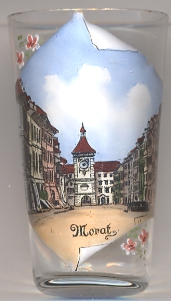

|
| SCHWEIZ / SUISSE / SVIZZERA / SVIZRA | SWITZERLAND |
| Freiburg / Fribourg / Friborgo / Friburg |
Murten (in French: Morat) is situated at an elevation of 453 m on the southern shores of Lake Morat. Morat is situated between Bern and Lausanne and is the capital of the Seebezirk (District du Lac) of the canton of Fribourg. It is one of the municipalities with a large majority (about 75%) of German speakers in the mostly French speaking Canton of Fribourg. In 1975 the former municipality of Burg bei Murten merged into the municipality of Murten, followed in 1991 by the former municipality of Altavilla and in 2013 by the former municipality of Büchslen. The municipality of Murten has a population of about 6,400 (2011).
The town's name derives from the Celtic word moriduno, meaning "lakeside fortress". It was first mentioned in 515 as a defensive place called Muratum.
In 1079 Emperor Heinrich IV granted Murten and other properties to the bishop of Lausanne. Murten was founded in either 1159 or during the
1170s or 1180s next to the fortress. Murten was first mentioned as a city in 1238. Although having been recognized as a Free Imperial City by Emperor Friedrich II
it fell under the protection of Count Peter II of Savoy in 1255. Murten began to develop alliances and ties with the surrounding Swiss cities. In 1245 they created a treaty
with Fribourg, followed in 1335 with Bern. On 22 June 1476, Charles the Bold, Duke of Burgundy, laid siege to the place in an action known as the
Battle of Murten. The town hung on for 13 days but finally was saved by the Bernese army. The enemy's army was destroyed completely — some 10,000 Burgundians
were killed. Since then, Murten celebrates the victory every year on 22 June. From 1484 on, and for 300 years, Murten was ruled by the two cantons — Bern
and Fribourg. In 1530, under pressure from Bern, Murten adopted the Protestant Reformation. Murten's Protestant faith often brought the city into conflicts with the more conservative,
 Catholic Fribourg. During the second half of the 17th century the city grew wealthy on trade over the road from Bern to Vaud and along the Broye river to Yverdon. Following the 1798
French invasion, under the Helvetic Republic Murten was part of the Canton of Saane and Broye. When the Republic collapsed, the Act of Mediation in 1803 gave the town to the canton
of Fribourg. Industrialization began in Murten in the early 1850s. In 1856, a plan to run the Lausanne–Bern railway line through Murten was shelved and the line was rerouted
through Fribourg. In 1875–1876 the Palézieux–Murten–Lyss railway line was constructed. This first line was followed in 1898 with the Freiburg–Murten line and in
1903 with the Murten–Ins line. Steamship service between Murten and Neuchâtel began in 1835.
Catholic Fribourg. During the second half of the 17th century the city grew wealthy on trade over the road from Bern to Vaud and along the Broye river to Yverdon. Following the 1798
French invasion, under the Helvetic Republic Murten was part of the Canton of Saane and Broye. When the Republic collapsed, the Act of Mediation in 1803 gave the town to the canton
of Fribourg. Industrialization began in Murten in the early 1850s. In 1856, a plan to run the Lausanne–Bern railway line through Murten was shelved and the line was rerouted
through Fribourg. In 1875–1876 the Palézieux–Murten–Lyss railway line was constructed. This first line was followed in 1898 with the Freiburg–Murten line and in
1903 with the Murten–Ins line. Steamship service between Murten and Neuchâtel began in 1835.
The  Berntor (Berne Gate) [left] was first mentioned in 1239. It was completely destoyed in 1476 during the Battle of Murten.
Over the years, it had to be rebuilt several times. Today’s Berntor dates from the second half of the 18th century, when it was built by Berne’s master architect, Niklaus Hebler,
who also renovated the famous “Zytglogge” Tower in Berne.
The clock, high above on the Bern Gate, was made in 1712 by Ducommun Brothers in La Chaux-de-Fonds. It is still wound every day.
Three heavy stones, probably cannonballs from the Battle of Murten, are raised by hand cranking every 24 hours. The clock face on the outside wall has only a one
hour hand. This symbolic "hand of oath" signifies that Murten was once was a Free City.
Berntor (Berne Gate) [left] was first mentioned in 1239. It was completely destoyed in 1476 during the Battle of Murten.
Over the years, it had to be rebuilt several times. Today’s Berntor dates from the second half of the 18th century, when it was built by Berne’s master architect, Niklaus Hebler,
who also renovated the famous “Zytglogge” Tower in Berne.
The clock, high above on the Bern Gate, was made in 1712 by Ducommun Brothers in La Chaux-de-Fonds. It is still wound every day.
Three heavy stones, probably cannonballs from the Battle of Murten, are raised by hand cranking every 24 hours. The clock face on the outside wall has only a one
hour hand. This symbolic "hand of oath" signifies that Murten was once was a Free City.
[https://de.wikipedia.org/wiki/Murten, http://en.wikipedia.org/wiki/Murten, http://www.murtentourismus.ch/en/bern-gate.html]
![[scale]](lineal.jpg)